|
Posted: 9/2/2008 4:56:04 AM EDT
[Last Edit: Small_Arms_Collector]
I originally posted this in General Discussion, but I figured it would be good here to, I see allot of posts talking about when the next class is, but no posts with any actual information in them, so I thought I'd add one.
Thought I'd give anyone who didn't know a quick tutorial on how to check Windage, and then how to figure out how many clicks to adjust your sights. First you'll need to figure out the wind speed, if you have a wind gauge this will be easy, if not, then you'll need to guess, you can take clues from things like the Range Flag, Tree Limbs, Smoke, and things like that, or just how it feels against your skin, but that takes practice,and experience, and easier trick is to pick up some dust, blades of grass, or something else similarly lite, and toss it into the air, and see how far it goes, it will move an average distance for each wind speed, the faster the wind, the farther it will go, if a wind blows it 1 foot, then that same speed wind will always move it one foot, if its dropped, or thrown from the same height, likewise if the wind were blowing twice as hard it would blow 2 feet, and so on. If your standing up face perpendicular to the direction of the wind, and throw the dust, grass, or whatever, then without moving extend your arm, and point to where it landed, then estimate the angle between your body, and your arm, for example if your arm were straight out that would be 90 Degrees, and if it were only half way up that would be 45 Degrees, once you figure out the angle, divide it by 4 that will give you your Wind Speed. For example if your angle was 40 you would divide by 4, and get 10, the wind is blowing at 10 miles per hour. 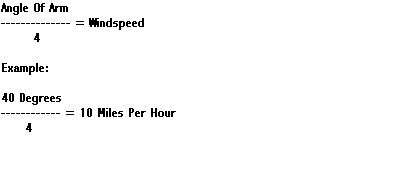 If time is a factor then you can simplify it a bit at a cost of precision, just divide the sweep of your arm into 5 Equal Parts, each part represents 5Mph. Here's a crude illustration: 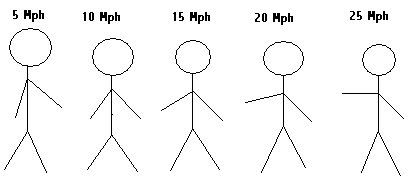 If your on the Range you can use the flag in the same way as your arm, just estimate the angle between the bottom of the Flag, and the Pole. 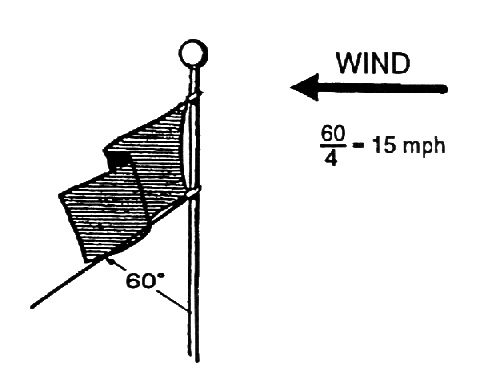 OK so now you know how fast the wind is going, how does that translate into "clicks"? Well like we discovered with the dust/grass earlier the harder the wind blows the more it will move the Grass/Dust, or in this case the Bullet, and likewise the farther down range it goes the more the Wind will affect it, for example at 200 Yards, just a 10 Mile Per Hour Wind will cause you to miss by 2 inches unless you correct for it. Here's a Diagram to show you what's going on: 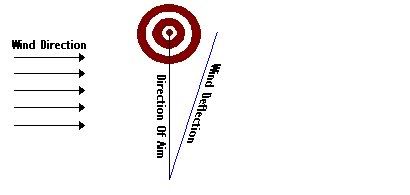 So how do you correct for it?, easy you shoot into the wind so that by the time the Bullet reaches the Target, it will be blown back on course, and the point of impact will coincide with the point of aim. Here's another chart to show you: 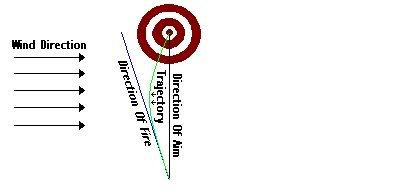 So you have to use an offset, you could use Kentucky Windage, but that's imprecise, and not what were discussing. The slightest change of angle on the Firing Line will translate into huge changes down range, so how do you know how far to move the Rear Sight?, well that's where those "clicks" come in, 1 Click equals 1 Inch at 100 Yards, 2 Inches at 200 Yards, and so on, so how do you know how many clicks that you need without firing?, well there's a simple Formula for that, just Multiply you Wind Speed by the Range in Hundreds of Yards for example 200, would be 2, and 500 would be 5, and so on, then divide by 10, and that gives you the Number of Clicks that you need. For example if your target was at 400 Yards, and your Wind Speed was 10 Miles Per Hour, you would just Multiply 4 by 10, then divide by 10, and get 4, you would nee to adjust your Windage 4 Clicks. It looks like this:  If you come up with an answer with a .5, you would round up to the next full click, for example 4.5 Clicks, would be 5 Clicks. You know how many Clicks you need now, but how which way to turn the Dial?, easy you adjust it in the direction that the wind is coming from, so for example if the Wind was coming out of your Right you would move the Rear Sight to the Right, but what if it's coming straight at you, or from behind? Well in that case no adjustment is Required. So that's all fine if the wind were coming from straight in front, from behind, or from Either side, what if it's coming at an angle? Well imagine that your standing in the middle of a Clock Facelike so: 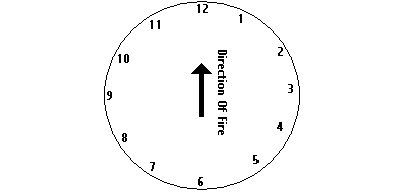 12 O'clock is directly in front of you, so Wind from 12 O'clock, and 6 O'clock would not require any Correction, 3 O'clock would be Directly to your Right, and 9 O'Clock will be Directly do your Left, so those would be just like I described earlier, 2,4,10,and 8 O'clock are Close enough to 3, and 9 O'clock to not matter, so treat them the same as you would a Wind coming out of 3, or 9 O'clock respectively, 1,11,7,and 5 O'clock Would only receive a Glancing Blow from the Wind, and would thus only need Half as many Clicks, so for the example above 12 O'clock, and 6 O'clock would receive no Clicks, 2,3,4,8,9, and 10 would Receive 4 Clicks, and 1,5,7,and 11 O'clock would Receive 2 Clicks. Here's another Chart to show you:  If your still a Little Confused watch this link, and watch part 2, and the Captain will explain it to you. |
|
|
|
|
[Last Edit: slapshot308]
[#1]
Nice charts and good write up.
Items of note: The flag method works but it is intended to be used with NRA wind flags that are of specific dimensions and weights. A lighter (like a Nylon USA or State flag), stiffer (smaller) or heavier (canvas) flag will give you false readings. Mirage is a better story teller as to what the winds are doing. Wind values blowing close to the shooter usually have greater effect than wind values close to the target. Find the dominant wind and what/where its doing its business. In the 6th picture, concerning Correction you've kinda gone the long way around the barn and "mis-identified" the correction value. You first need to establish the Effective Wind Value. Wind velocity times wind correction value (see: Wind Rosetta pic #8) equals Effective Wind Value. Effective wind value times (range / 10), then divide by constant equals correction in MINUTES OF ANGLE... not clicks. If for some reason you're working in the "click" world you need to convert the MOA value to "click" value based off your sight's value. Also, one needs to know if their sight in TMOA or SMOA correction values. This becomes more important at distance than with closer engagements. Again... the long way around the barn. Example 1: Wind at 10 mph from 9 o'clock at 1,000 yards using M118LR 10 x 1 = 10 (duh right... I know) 10 x 10 / 11 = 9.1 MOA Add 9 MOA Left Correction to compensate for wind or hold 2.5 mils left and send it. Example 2 (same, but the wind has shifted and is now out of the 11 o'clock): 10 x .5 = 5 5 x 10 / 11 = 4.1 Reduce correction to 4 MOA Left Correction or hold 1.1 mils left and send it. Nothing wrong with how you stated it, except that junior shooters will add in adjustment then go back to doing math to try and develop the esitamted wind value. Many get lost, confused, and frustrated at this point because the winds shift, reduce or increase in velocity, or they forget what adjustment they just put on thier sight.. Figuring the estimated wind value first just cuts some time off the math and the chance that the wind will shift again. Additionaly, one needs to pay attention to the constant wind value noting what the constatnt winds are doing, not the switches and gusts. Also, a tailwind will reduce TOF and require a bit less elevation correction. A headwind will increase TOF and require some additional elevation correction. Both are slight and are dependant on range concerning correction. In other words, at 200 yards a shot into a 10 mph headwind will show little to almost no shot deflection. That same shot at 1,000 yards will require 0.5 MOA correction or more depending on other enviromental factors. May not sound like a lot but the "X" on an F-Class target is 0.5 MOA at 1,000 yards. |
|
|
|
|
[#2]
Good thread. Deserving of a tack.
|
|
|
Best Regards,
TonyF Training Forum Moderator "... there's trained and untrained" (Denzel Washington -- Man on Fire) |
|
[#3]
Wow thanks. |
||
|
|
|
[#4]
Nice post!
|
|
|
F.O.
|
|
[Last Edit: djm227]
[#5]
any chance of getting the pics back up?
EDIT: I can't believe I wasted my 1000th post on this thread. 
|
|
|
stay safe, stay second amendment
|
|
[#6]
Very well written...TY
|
|
|
|
|
[#7]
forward the pics to me and i'll host them on my server.
|
|
|
|
|
[Last Edit: Razoreye]
[#8]
Nvm.
|
|
|
|
|
[#9]
Has anyone ever heard of the rule of 9?
if you are shooting 7.62 ((range in meters/100) x (wind speed mph)) = hold per 1/4 mil 9
((300m/100) x (3mph)) = 1/4 mil into wind 9
It works really well out to about 900 meters |
|
|
|
|
[#10]
One thing I've also noticed is that the easily-read wind on the ground under your bullet's flight path is not the same wind as the bullet will encounter in its slightly or significantly higher altitude, depending on the range and caliber you shoot. Since there is more wind resistance on the ground, it is almost always much slower on the ground.
Wind-reading is a rainbow I have been chasing since I was a kid, and I'm still learning. I have found that once you really start to pay closer attention to it, you can see the real effects of value shifts, like a 1/2 wind value shifting to a full with regards to wind direction, and the necessity to compensate for those shifts. I noticed that a lot of guys like to get up early and try to beat the wind before it kicks up in the morning with solar heating, but you will almost never have that option in competition/real world, so I don't shy away from shooting in the most horrible conditions I can stand. Doing it in blowing snow, rain, & from various positions has given me a better grasp of realistic capabilities and limitations, and I have often been surprised at how far a shot can be made when you would have written it off. Once the distances start getting past 700, we all know that we often end up with a registered shot, and not a 1st-round hit. At that point, I race to get my correction and shoot the correction, then settle that last moment before sending it through a good sight picture, otherwise, I lose a known condition and will chase the wind, especially with a .308. Most competitions I have done end up being a humble pie experience for everyone, and the team or shooter who sucks the least wins. Wind is always the humbling factor, along with novice lessons that have to be re-learned because a seasoned shooter took it for granted that his scope mount was secure, or lost revolutions on a turret without zero-stop. Those are painful episodes to watch, especially in a team match, where the shooter knows he is letting down his partner in addition to himself. There is nothing than can replace trigger time, or better yet, spotting scope time in the wind, watching how your pills behave at distance in a chaotic environment with very few quantifiable measures before taking the first shot. |
|
|
|
|
[#11]
There is another way to get windage for your rifle and ammo. If your at the practice range and your rifle is zeroed then you can fire a good group. You record the wind and were your group is. Look at the range flags and record what they looked like when you fired that group. Repeat this process and you will see what the wind does to you and your rifle and ammo. If you keep a log with your corrections for certain range conditions then you can look back and study.Then you can take this info to a match and you will know what a similar wind has done to your groups in the past.
When I was in the corps and on the firing line we did not have anything with use but a rifle and ammo. The only way we knew windage was buy recording range conditions and dialed in corrections. If anyone here has shot on a range in camp Pendleton they can tell you that you can see the range flags flying in all directions. The wind comes in and swirls around so there is no way to use a wind meter or wind flags to get a wind value. But with a week or two of practice we were able to get used to the conditions and get center mass hits. There is no substitute for trigger time. You must shoot your rifle in all conditions and see what you can do with it. The ballistics and wind charts may say one thing but your rifle,ammo,sight alignment,site picture and trigger control may say another. I hope some day I can use a chart and math to get shots in the v ring but my brain does not work that way. I have never bin good in school but if you let me do it i can figure it out. Please don't get me wrong wind charts and mathematical equations are great for those that can use them. For people like me, that would take 2 hours to figure out the math the match would be over before I fired a shot. 10 x something divided by such and such squared to the n'th power = massive headache. But give me my rifle and range book and I can touch the black. This is JUST my opinion and I don't want anyone to think I know much about, well anything actually. Just trying to give another solution to a problem... |
|
|
|
|
[#12]
Very nice
|
|
|
|
|
[#13]
Its really all science. If you cant crunch the numbers in your head, which takes repitition, you need a computer. You can also use a chart or create a windage wheel, which is a old school slide rule calculator with your data on it. The most effective long range shooters know their math and know the science behind it. I could work with anyone with weak math skills and get you on target by repetitive practice. If you cant or are not willing to do the math, you will never shoot 700+ without a computer and a prayer.
|
|
|
|
|
[#14]
Great Post, As a newer long range shooter this was very simple to understand and will make my shots on target. Thank You Sir!
|
|
|
|
|
[Last Edit: Trollslayer]
[#15]
I learned more about long distance by shooting during the poor wind conditions than I would have ever learned shooting in good conditions.
It helped that it was a training day because there was no time pressure. Also, discussion of each shot or small group of shots was allowed between the spotter and myself. Being the spotter was also educational, as you can role play as the shooter, watching the flags and making the call when they make their shot. P.S. - Boy, this forum is stone cold dead! |
|
|
|
|
[#16]
I was taught to dial elevation, for a constant distance, but hold off for wind because it changes rapidly.
Now, that's with an appropriate reticle in a scope so YMMV. 0.2 mil windage marks are awesome for this. |
|
|
|
 Win a FREE Membership!
Win a FREE Membership!
Sign up for the ARFCOM weekly newsletter and be entered to win a free ARFCOM membership. One new winner* is announced every week!
You will receive an email every Friday morning featuring the latest chatter from the hottest topics, breaking news surrounding legislation, as well as exclusive deals only available to ARFCOM email subscribers.
AR15.COM is the world's largest firearm community and is a gathering place for firearm enthusiasts of all types.
From hunters and military members, to competition shooters and general firearm enthusiasts, we welcome anyone who values and respects the way of the firearm.
Subscribe to our monthly Newsletter to receive firearm news, product discounts from your favorite Industry Partners, and more.
Copyright © 1996-2024 AR15.COM LLC. All Rights Reserved.
Any use of this content without express written consent is prohibited.
AR15.Com reserves the right to overwrite or replace any affiliate, commercial, or monetizable links, posted by users, with our own.

